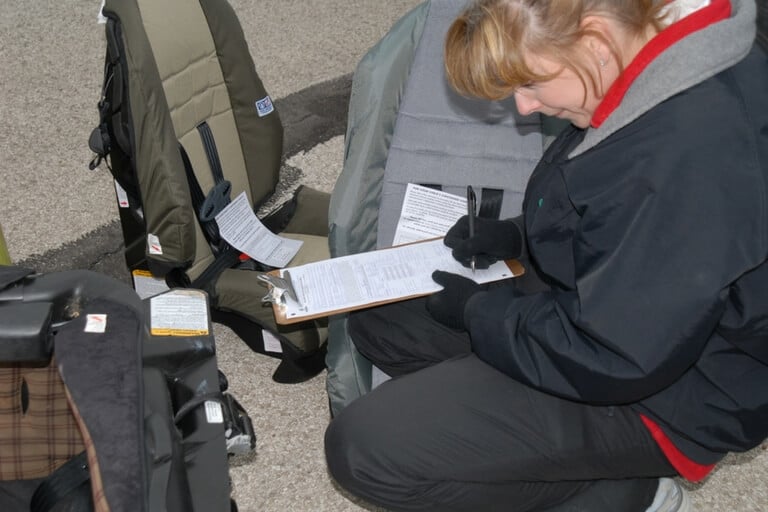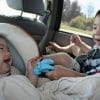The best car seat for your child is not always the most expensive. So long as it fits your car and your most precious passenger’s height and weight, you’re on the right track.
What you should ask, however, is:
How to install a car seat?
Most parents will assume they’re doing it right. But is that indeed the case?
The Journal of Pediatrics published an eye-opening study involving 291 parents (mostly between the ages of 25 and 34). They were surveyed and observed by certified car seat technicians as they installed their seats and positioned their babies.
And the results?
- 21% used non-regulated products
- 69% had the harness too loose
- 16% of them used lower anchors in the middle sit
- 23% of the time the seatbelts were in the incorrect path
- 31% placed the harness in the wrong slot
- 17% had the buckle straps too far from the baby
- 17% of the time the caregiver was unable to adjust the harness
The list of car seat installation errors go on, but here’s the bottom line:
Only 5% of the participating parents installed the car seats without making a mistake.
Yes, 19 out of 20 parents do it the wrong way.
How To Install A Car Seat – Why Make It A Big Deal?
Why should it not be?
Think about it:
We buy car seats protect our little ones while we’re on the road. But no matter how impressive a model is, improper car seat installation will render it useless and unsafe.
An improperly installed seat will not protect your baby from injuries in case of a crash, injuries that can prove life-threatening especially for children.
The Biggest Mistakes In Installing Car Seats
Mistakes happen for many reasons. For starters, car seats are complicated. Second, instruction manuals can be hard to understand. Third, many people just don’t follow the instructions or don’t know how to.
The most prominent mistakes in installing car seats are as follows:
Incorrect Recline Angle
This error often applies to infant car seats. You see, babies need to be in a semi-reclined position to keep their airways open. Almost all of these car seats have angle indicators and adjusters to guide you.
Unfortunately, most parents tend to install the seats in a position that’s too upright.
Why it’s dangerous: Your baby’s head may flop forward since his head is still too heavy for him, blocking his airways and suffocating him in the process.
The fix: Put a cut-up swimming pool noodle under the area where your child’s feet are to make sure the seat reclines at the correct angle.
Car Seat Too Loose
A car seat needs to fit snugly inside your vehicle. As a rule after installation, moving it more than an inch to the left, right, or forward shouldn’t be possible.
Why it’s dangerous: A loose car seat could crash straight into the back of the front seat during a collision, causing severe injury to the head.
The fix: Tighten the seatbelt as much as possible by placing your knee into the seat while putting all your weight on it. And don’t forget to lock the belts after.
Changing To The Next Car Seat Too Soon
Babies must remain in rear-facing or newborn seats for as long as possible. Keep the seat (or mode if using a convertible) until your child reaches the weight and height limit. The same principle applies when changing to a booster seat for an older child.
Why it’s dangerous: The limits of a car seat are there to give your little ones the utmost protection especially since their bodies are still developing. Changing to a different seat too soon puts your child at risk if he can’t support his body yet.
The fix: Don’t get too excited. Follow the limits of the car seat to the smallest details. If unsure, go to safety check stations near you to confirm.
Harness Is Too Loose
Loose harnesses are as typical of a mistake as loose car seats. Do the pinch test to know if the harness is too loose. If you’re able to pinch the fabric of the harness straps between your fingers after tucking your child in, that means you need to tighten it a bit more.
Be careful not to tighten the harness too much though, or your little angel might have difficulty breathing.
Why it’s dangerous: A loose harness can propel your child out of the car seat during a crash. It can cause severe injuries not only to him but other passengers in the vehicle as well.
The fix: The pinch test works well in checking how tight the harness is.
How Do You know If You Installed The Car Seat Properly?
Given that we’re not professionals when it comes to car seat installations, how can we confirm if we did it correctly?
The bad news: You can’t unless you seek a technicians help.
The good news: The National Highway Traffic Safety Administration (NHTSA) has a state-by-state listing of child safety-seat check stations where experts will check the seats and correct any possible installation mistake.
The bonus? The service is free!
If you can’t go to a nearby station, however, the best practices and tips below will help you ace the installation process.
Car Seat Installation Tips
Infant Car Seat (rear-facing)
- Install at a 45° angle. If your infant car seat doesn’t have an angle adjuster or indicator, place a cut-up swimming pool noodle under the base. A tightly rolled towel works well too.
- The car seat should not move more than an inch when you tug on them in any direction.
- Install away from active airbags. The safest is in the backseat of a car and second or third row in a mini-van.
- The harness straps should not twist or fold and should pass through the correct slots. The right slots are at or below your child’s shoulders, with the top of the harness clip being at armpit level.
- If your vehicle was manufactured before the 1st of September 2002, install the car seat with the safety belt. Otherwise, use the LATCH (Lower Anchors and Tethers for CHildren) system.
Convertible Car Seat (rear-facing)
- Like infant car seats, it should recline at a 45° angle. For older babies with good head control, about 35° is okay.
- Have an older child fold or cross his legs to stay comfortable.
- Make sure that the harness is snug.
- Check your car seat manual to see if you can use top tether of a convertible in rear-facing mode.
Forward-Facing Car Seat
- Install away from active airbags.
- Secure the tether only to the anchor point(s) provided. Contact your dealer to install one if it didn’t come with any.
- The harness chest clip needs to lie flat against your child’s chest at armpit level.
- Tug at the car seat each time you tuck your child in to make sure it’s secure.
- Contrary to a rear-facing car seat, a forward-facing seat needs to sit at an upright angle.
Booster Seat
- Install booster seats away from active airbags.
- The lap belt should touch the top of your child’s thighs, below his hip bones – not the abdomen.
- If your car’s seat doesn’t have a headrest or has a low seat back, then getting a high-back booster is recommended.
- The shoulder belt should cross midway between the neck and arm.
- Always use both the shoulder belt and lap belt together in booster seats.
Top Car Seat Brands For Ease Of Installation
Britax
Britax has been a well-known car seat maker for a while. Their self-patented ClickTight system ensures installation is as simple and secure as they should be. When you hear an audible ‘click’ sound, you can rest easy knowing that you did the installation correctly.
Chicco
Chicco, on the other hand, has their SuperCinch LATCH Tightener. It’s a very cool feature which uses force-multiplying technology to get a super tight and secure vehicle fit with minimal effort.
Graco
If Britax has the ClickTight System, Graco has their Click Connect Technology. It provides a secure, one-step attachment between their infant car seats to your vehicle. This technology also ensures the same hassle-free installation with all of their Click Connect-compatible strollers.
Safety 1st
Car seat makers keep on making newer ways to help parents with the installation. Safety 1st has their Quick Fit Harness. It offers additional security and convenience by letting you adjust the height of both the harness and headrest. It’s effortless to do and rest assured that your child is always snugly tucked in the car seat.
Conclusion
To help you find the best car seats together with information on how well they install, you can visit NHTSA’s Child Safety Seat Ease of Use Ratings.
Our job as parents is never-ending. That’s a fact. And as far as car seats are concerned, our job doesn’t stop after getting the best one. We always have to make sure that we install and use them correctly. After all, our kids are our most precious passengers.


